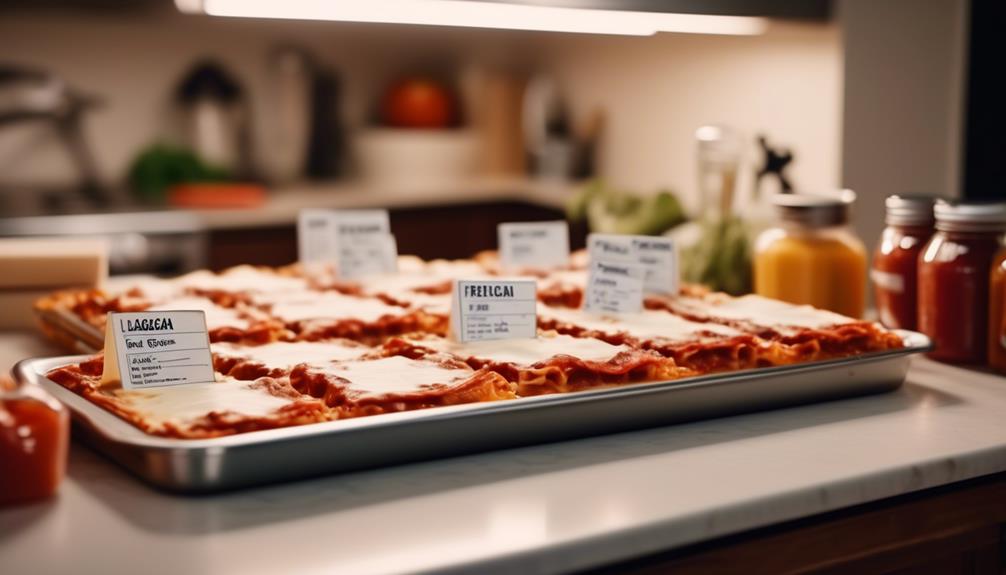Just as a skilled artist prepares their canvas before painting, you must carefully prepare your lasagna for the deep freeze to preserve its flavors and textures.
You'll start by selecting the finest ingredients, ensuring your lasagna is not only delicious fresh out of the oven but also after it has been frozen.
It's crucial to cook your pasta to just the right degree of doneness, as it will undergo a second round of cooking when reheated.
You'll also need to cool your dish properly before packaging it, using materials that protect it from freezer burn and the mixing of odors.
Wrapping your lasagna tightly and securely is the next step, giving particular attention to sealing out air, the enemy of frozen foods.
By following these traditional, detailed, and clear guidelines, you'll ensure that your lasagna freezes beautifully, ready to be enjoyed at a moment's notice.
However, the key to maintaining the integrity of your layered masterpiece lies in a few more steps, the knowledge of which could mean the difference between a soggy disappointment and a triumphant Italian feast on a busy weeknight.
Key Takeaways
- Choose high-quality ingredients like fresh tomatoes, creamy ricotta, freshly grated Parmesan, and moist mozzarella for the best lasagna flavor.
- Perfect the layering technique and ensure each layer is even, with the final layer of sauce covering the noodles completely.
- Use a freezer and oven-safe baking dish or disposable aluminum foil pans for smooth transitioning and convenience.
- Double-wrap the lasagna with plastic wrap and aluminum foil, use an airtight, freezer-safe container, and label it with the date of freezing and contents for proper storage and easy identification.
Choosing the Right Ingredients
Selecting high-quality, fresh ingredients is the cornerstone of preparing a lasagna that not only tastes delicious fresh but also freezes and reheats well. Ingredient quality can't be overstated; it's crucial to the success of your dish.
Start by sourcing the best possible tomatoes for your sauce. Whether you choose sun-ripened fresh tomatoes to make your sauce from scratch or opt for canned ones, ensure they're of the highest quality, free from blemishes, and have a rich, vibrant color.
For the cheese choices, traditional lasagna calls for creamy ricotta, which should be as fresh as possible, with a smooth texture and a clean, milky flavor. Parmesan, another essential, should be freshly grated rather than pre-packaged to preserve its bold, nutty essence. Mozzarella, the third musketeer in your cheese ensemble, should be moist but not too wet. Opt for whole milk mozzarella for a richer taste and superior meltability.
Preparing Lasagna for Freezing
Once your lasagna is assembled with top-notch ingredients, it's crucial to follow specific steps to ensure it freezes beautifully and tastes as if it was made fresh. Perfecting the layering technique plays a significant role in how well your lasagna holds up in the freezer. Make sure each layer is even and that the final layer of sauce covers the noodles completely to prevent them from drying out.
Selecting the right baking dish is also essential. Use a dish that is both freezer and oven-safe to transition smoothly from freezing to baking without the need for dish changes. Aluminum foil pans can be a convenient option as they are disposable and provide a good seal for freezing.
Here's a quick guide on preparing your lasagna for freezing:
| Step | Description | Tip |
|---|---|---|
| 1. Cool | Allow lasagna to cool completely before freezing. | Prevents ice crystals. |
| 2. Wrap | Tightly wrap the dish in plastic wrap, then aluminum foil. | Double wrap for protection. |
| 3. Label | Clearly label the lasagna with the date and contents. | Keeps track of freshness. |
Wrapping and Packaging Tips
After ensuring your lasagna has cooled and you've found the perfect dish, the next crucial step is to wrap and package it properly to maintain its quality during freezing. Achieving strong seal integrity is essential to protect the lasagna from freezer burn and prevent the absorption of odors from other foods in your freezer.
Here are three key tips to help you wrap and package your lasagna:
- Double-Wrap for Extra Protection: Begin by wrapping your lasagna tightly in plastic wrap. Make sure to press out as much air as possible before sealing. Follow up with a layer of heavy-duty aluminum foil. This double-layer technique ensures an airtight seal, keeping your lasagna fresh.
- Choose the Right Container: If you're not freezing the lasagna in its baking dish, transfer it to an airtight, freezer-safe container. Make sure the container fits the lasagna snugly to minimize the amount of air trapped inside.
- Employ Effective Labeling Methods: Use freezer tape and a permanent marker to label the wrapped lasagna with the date of freezing and contents. Accurate labeling methods will help you keep track of how long the lasagna has been stored and avoid any confusion with other frozen meals.
Freezing and Storage Guidelines
Properly freezing your lasagna not only extends its shelf life but also preserves its flavor and texture for future enjoyment. To ensure the best results, you must store your lasagna at optimal temperatures, which for a freezer is at or below 0°F (-18°C). This temperature halts bacterial growth and maintains the quality of your dish.
When selecting a container for your lasagna, container choices should be airtight and freezer-safe to prevent freezer burn and the absorption of other odors. Glass baking dishes with airtight lids or heavy-duty aluminum foil containers are suitable choices. If you're using a dish that's not specifically designed for freezing, wrap the lasagna tightly with plastic freezer wrap or aluminum foil before placing it in a heavy-duty freezer bag.
Remember to label your container with the date of freezing. Lasagna can be stored in the freezer for up to three months without significant loss of taste or texture. However, for the best experience, it's recommended to consume it within the first month.
When you're ready to enjoy your lasagna again, thaw it safely in the refrigerator before reheating it to a temperature of 165°F (74°C) to ensure food safety.
Thawing and Reheating Instructions
Having mastered the art of freezing lasagna to preserve its quality, it's crucial to understand the steps for safely thawing and reheating your dish to enjoy its full flavor. When you're ready to dive back into that comforting taste, follow these detailed, traditional, and clear steps:
- Thaw your lasagna in the refrigerator for 24 hours before you plan to eat it. This slow process ensures even thawing and maintains the lasagna's texture and taste.
- Preheat your oven to 375°F (190°C) for oven consistency. Transfer the lasagna to an oven-safe dish if it's not already in one.
- Cover the lasagna with foil to prevent it from drying out and bake it for approximately 25 minutes. Then, remove the foil and bake for another 10-15 minutes until it's hot and bubbly.
If you're short on time, you can use the microwave, but be mindful of microwave safety. Cover the lasagna with a microwave-safe lid or wrap to avoid splatters and heat it on medium power in two-minute intervals, checking its progress. The goal is to heat it thoroughly without compromising the integrity of the dish.
Bon appétit!

